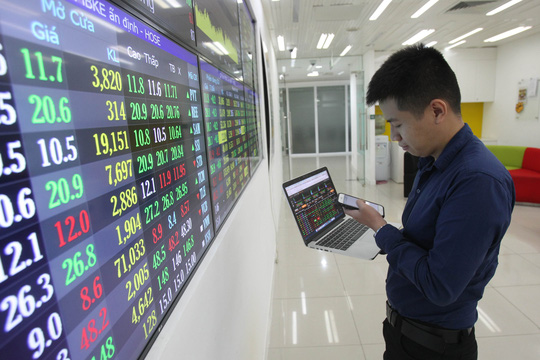The ongoing COVID-19 outbreak is showing more positive signs, with higher vaccination rates and a decline in the number of new infections, raising hopes for businesses of a return to normality and providing support for the stock market.

The market benchmark VN-Index had gained around 20 per cent since the beginning of the year, and even hit the historic level of more than 1,400 points, despite the ongoing pandemic. The stock market has been considered an attractive investment channel since last year, amid low interest rates and bright outlooks for business results.
It witnessed a sideways trend in recent weeks, showing investors’ hesitation in the context of strong correction risks. But looking over previous outbreaks, there are still opportunities, especially when the pandemic is gradually brought under control.
A report from Agribank Securities Corporation (Agriseco) showed that before the number of new infection cases peaked in the first three outbreaks, most stock groups recorded a downtrend. However, once the pandemic was gradually under control and the number of new cases peaked, many stock groups, especially cyclical stocks such as banks, financial services and chemical stocks, edged higher.
Therefore, the gradual easing of social distancing measures in many provinces and cities, and the resumption of business activities can be positive signs for the market.
“The easing of social distancing measures and the reopening of businesses are expected to have a positive impact on the market’s sentiment, helping the market to get out of the sideways trend since businesses’ performance is a factor supporting the market's outlook,” Le Xuan, a senior trader, told Viet Nam News.
However, Phan Dung Khanh, Head of Investment Advisory at Maybank Kim Eng, said that even though it is great news that the economy reopens, the event will not affect the market much as it is weighed by many other factors.
“The plan was widely expected and has been already priced into the market, so it doesn't have much impact,” Khanh said.
“Moreover, it will gradually reopen, not quickly, and enterprises still have to pay many other expenses in order to operate again amid a shortage of workers."
Investors’ confidence hasn’t returned after the market witnessed rising net sold value in the last two years, Khanh added. In the first eight months of the year, the net sold value was double that of last year, while last year recorded the biggest net sold value in a decade.
The country’s stock market was also weighed by the downtrend pressure, the fall over three consecutive weeks of the global market and the impact of events in China on Asian markets, the expert said.
Chinese real estate giant Evergrande’s debt crisis sent shock waves across global markets on September 20.
Data compiled by Agriseco showed that the VN-Index rebounded about 20 per cent from when the number of new infection cases peaked to when the disease was contained.
Xuan expects stocks in retail sectors to recover thanks to high demand for consumer goods and food during social distancing orders.
Construction material producers will also attract investors' interest as the peak of disbursement of public investment is still in the medium term of the 2022-2025 period.
"Public investment is considered a weapon against economic downturn," Xuan said.
On the other hand, Khanh said that the strong rally trend of small-cap stocks will continue until the end of 2021 and even extend to next year. It is because the ongoing weak large-cap stocks weigh the benchmark, causing cash flows to shift to smaller stocks.
However, in the medium- and long-term, he expects listed companies related to transportation, tourism, entertainment and hotel industries, which were affected by the pandemic but can overcome the tough times, to still have potential.
In the report, Agriceso also sees only a few stock groups with better prospects. Besides construction materials and retail stocks, it forecasted that chemical stocks will grow once the pandemic is totally contained.
The industry benefits from the disruption of the global supply chains, pushing commodities prices up. Prices of rubber latex, DAP, Urea, and phosphate fertilisers were 3-digits higher compared to the beginning of the year. Moreover, the demand for some commodities such as yellow phosphorus and fertilisers is increasing in the international markets, helping these enterprises to benefit from exports, the securities firm added.
For the rest of the year, insiders see mixed results for the market.
Khanh from Maybank Kim Eng said that the market is expected to continue the current sideways trend and might even tumble, while small-cap stocks remain strong.
Meanwhile, Xuan sees a more bullish scenario.
“With the Government's efforts and determination in controlling the pandemic and speeding up the vaccination rollout, production activities can be gradually restored from October. Therefore, the production index is expected to recover and grow again in the fourth quarter, which will positively affect investors' sentiment and the stock market,” said Xuan.
She also expected that by the end of this year, the VN-Index can reach 1,500 points if the COVID-19 outbreak is contained in the third quarter. — VNS





